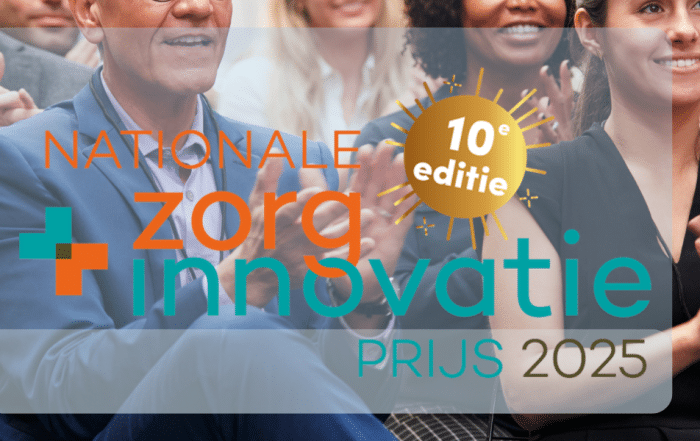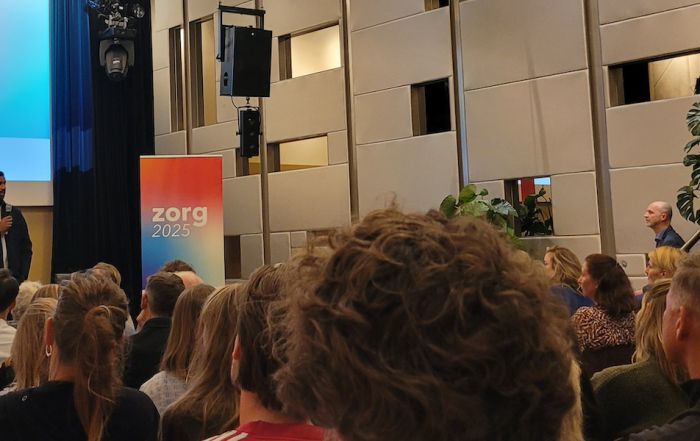Contenders regional preliminaries Zorginnovatieprijs
Three groundbreaking healthcare innovations have been selected for the regional preliminaries of the National Zorginnovatieprijs 2025. It is the award for the most innovative scale-up in the field of care and well-being. Who are these contenders, and what makes their innovation special?
Lennart Zielstra, co-founder of Rezolve Medical, talks about the revolutionary design of Rise. Wouter Kroese, founder of Pacmed, discusses the importance for ICU physicians of Pacmed Critical. Co-founder Femke Delissen gives insight into convenience of motion sensor PAVA. The Zorg2040 partners, organisers of the regional preliminaries, are happy to highlight these great healthcare innovations.
All three candidates talk about how the idea for their product came about and how it developed. They also discuss stumbling blocks along the way and solutions. And: why did they apply to participate in this competition?
‘Rise gives tailored ankle and foot support’
Traditional ankle-foot orthoses (AFOs) often fail users, due to discomfort and stiffness. Rezolve Medical’ s Rise AFO solves this with a revolutionary design. The 3D printed, personalised solution provides optimal support with natural freedom of movement, says Lennart Zielstra.
How did the idea for your product come about?
“You could say the seed was planted when, as a teenager, I shattered my knee during a ski vacation. Due to a severed nerve, I have been unable to lift my left foot ever since. This so-called ‘footdrop’ gave me a somewhat wobbly gait. I was still affected by this years later when I started my master’s degree in Biomedical Engineering at TU Delft.
“Many people with a similar condition use a so-called ankle-foot orthosis. As do I. Such a brace has to be really tight against your foot and leg, and is therefore often quite uncomfortable. Moreover, the stiffness restricts your natural walking pattern. It made sense that I wanted to use my new knowledge to develop a better alternative.”
How was the development to date?
“After prolonged prototyping, the concept for the Rise ankle-foot orthosis emerged. This provides pressure on the upper side of the foot. Within instrument making, this is not done for various reasons. But my own experience showed that this actually works very well. There are definitely advantages to being your own target group.
“I did a lot of thinking and design work to develop options for personalising the Rise. After all, ideally you want to provide exactly the support an individual user needs. In addition to the innovative design, the accompanying software ensures that the printed brace can be completely customised.”
What challenges did you encounter? How did you overcome them?
“In addition to developing the Rise, we spent a lot of time positioning Rezolve Medical within the value chain. The market for these medical devices, or orthoses, is fairly complex. Rezolve therefore established contact with a series of manufacturers, medical authorities, patient associations and insurers. Among other things, this led to our cooperation with the provider of a software package for the fitting of orthoses. The fitting of the Rise is now integrated into this, and therefore simplified. This allows Rezolve to continue to focus on product development.”
What is your motivation for participating in this contest?
“Rezolve has taken the first valuable steps in our positioning. There are still plenty of other parties we need to convince that the Rise can make the impact we promise, and meet all medical standards. Such as the doctors who would prescribe our solution to patients. Because of the disadvantages of existing braces, they might hesitate to recommend them. We would like to convince them that the Rise is a real improvement.”
‘Pacmed Critical helps physicians with data-driven decisions’
Intensive care physicians need to be able to quickly assess many different types of data. Pacmed Critical ‘s AI tool analyses numerous data streams to support medical decisions, capacity forecasting and task automation, says founder Wouter Kroese.
How did the idea for your product come about?
“With my associates Willem Herter and Hidde Hovenkamp, I participated in the 2014 National Think Tank on the social value of Big Data. That was the buzzword for the advent of Artificial Intelligence. We marveled that the vast amounts of data generated by healthcare were not yet being harnessed. This was unlike many other industries. We started with software, which could offer GPs data-driven support in making medical decisions.”
How was the development to date?
“After that, we were active in all areas of care. During the Covid period, we decided to focus entirely on the Intensive Care Unit. Everything came together there: lots of available data sources, doctors who were open to data-driven work and a big capacity problem.
“With Amsterdam UMC, we started developing Intensive Care-focused AI software in 2017. Our focus here was initially on answering one key question: when is it safe to discharge a patient from the ICU? Our solution now brings together all the patient’s available data to predict the probability of readmission or death after discharge.”
What challenges did you encounter? How did you overcome them?
“The data we use is not collected primarily to develop AI-driven solutions. It is simply created during the clinical process, as a kind of digital trail. There are numerous ways in which that trail can contain errors, gaps or limitations. For example, a patient may end up in a different bed after performing a CT scan. If you interpret that as a ‘readmission’, that messes up the algorithm. Certainly during the initial product development, we spent eighty percent of our time trying to make all the available data suitable for creating reliable medical insights.”
What is your motivation for participating in this contest?
“We currently have four hospitals as customers, two of which have been using the software for a year. The first results are very positive. For example, there was a patient at Amsterdam UMC with a severe infection. Thanks to our software, they stayed one night longer in the ICU.
“In fact, the software signaled a very high chance of readmission. That same night, the patient had to return to the ICU for ventilation. On a nursing ward, such a situation would typically lead to death or long ICU readmission.
“We are now expanding Pacmed Critical into an ICU-wide suite. Enabling ICUs to provide more patients with personalised and appropriate care, with reduced pressure on staff.”
‘PAVA monitors movements and eases workload’
Using WiFi-sensing technology, PAVA monitors movement, location and sleep of residents in healthcare facilities. Co-founder Femke Delissen: The system is designed to ease the workload of care staff and increase care quality, without storing privacy-sensitive data.
How did the idea for your product come about?
“I met my three co-founders Tom, Thijs and Daan through the Artificial Intelligence master’s program at the Vrije Universiteit Amsterdam. Our idea came from an entrepreneurship course where we discussed monitoring problems in healthcare. PAVA uses WiFi sensing technology to signal movement: whether someone is walking, sitting or falling in a room.
“Current sensors often give false or late alarms. They overload caregivers, are poorly adjusted, or turning them on is forgotten. By providing remote insights into residents’ movements, we saw a more user-friendly alternative in WiFi sensing. Since it’s just a plug in a socket, we put minimal strain on the residents.”
How was the development to date?
“We first tested our self-developed software in the WiFi sensors on ourselves. Development gained momentum thanks to a collaboration with the ViVa! Zorggroep. During discussions with management and nursing staff there, we had already gathered information about the best possible use cases.
“This month we are starting a pilot, to demonstrate the accuracy of our data. Through this, we will help night shift staff spend their often limited time as efficiently as possible. They see which residents are sleeping peacefully and don’t need to be disturbed. Those who are awake are more likely to qualify for a monitoring visit. From there, we want to expand to similar use cases.”
What challenges did you encounter? How did you overcome them?
“Many healthcare institutions are open to innovative technology that can support their employees. However, they want validated technology that has already demonstrated its added value elsewhere. Participating in the development of new, unproven technology is much more difficult. It’s a chicken and egg situation. We owe a lot to ViVa!’s very enthusiastic innovation and site managers, who set this development in motion with us.”
What is your motivation for participating in this competition?
“We’ve been working on PAVA for a year, and could only give up our other jobs this summer. This competition is first and foremost a great opportunity to present ourselves as a healthcare innovation with extremely versatile application possibilities.
“We are looking for more contacts within healthcare facilities and home care, to offer and grow our product. For example, our technology can help older people live independently for longer. Given the advancing aging population, this is very socially relevant.”
More about the regional preliminaries of the Zorginnovatieprijs
On 21 January, three promising innovations from the provinces of North Holland and Flevoland will compete to get to the finals of the National Zorginnovatieprijs 2025.
During a closed Boardroom Pitchevent in the Koepel in Haarlem, the entrepreneurs will present their healthcare innovation to a professional jury and the organisers of this preliminary round: the Zorg2040 partners. The jury members will choose who wins the regional preliminaries and advances to the national finals.
Text: Arnoud Groot
10 December 2024
Read more about
Contact us
Want to keep up to date?
Get the best regional news and events (in Dutch) via the Board Update newsletter
Share this news
Want to keep informed?
Follow us daily on LinkedIn and sign up for the Board Update newsletter.
Read more
- On 14 and 15 October, board members of the Amsterdam Economic Board convened for ...
- Focusing more on women in health care innovation and research will have ...
- What is the Amsterdam Metropolitan Area’s position on critical raw materials? ...








